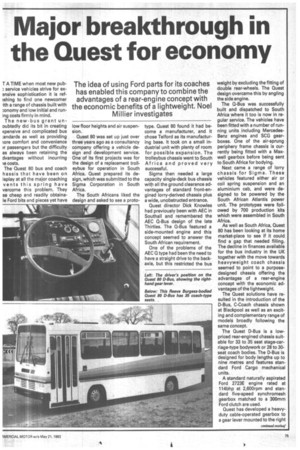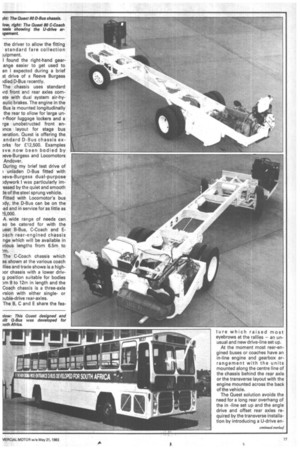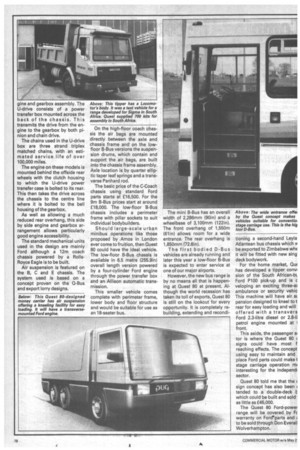Major breakthrough in the Quest for economy
Page 81

Page 83

Page 84

If you've noticed an error in this article please click here to report it so we can fix it.
The idea of using Ford parts for its coaches has enabled this company to combine the advantages of a rear-engine concept with the economic benefits of a lightweight. Noel Millier investigates
TA TIME when most new pub3 service vehicles strive for exansive sophistication it is refmhing to find one newcomer ith a range of chassis built with onomy and low initial and runrig costs firmly in mind.
The new-bus grant unoubtedly did its bit in creating 0( pensive and complicated bus :andards as well as providing lore comfort and convenience )r. passengers but the difficulty as always been retaining the dvantages without incurring le costs.
The Quest 80 bus and coach hassis that have been on 'splay at all the major coaching vents this spring have vercome this problem. They se cheap and readily obtainale Ford bits and pieces yet have low floor heights and air suspension.
Quest 80 was set up just over three years ago as a consultancy company offering a vehicle design and development service. One of its first projects was for the design of a replacement trolleybus for operation in South Africa. Quest prepared its design, which was submitted to the Sigma Corporation in South Africa.
The South Africans liked the design and asked to see a proto type. Quest 80 found it had become a manufacturer, and it chose Telford as its manufacturing base. It took on a small industrial unit with plenty of room for possible expansion. The trolleybus chassis went to South Africa and proved very successful.
Sigma then needed a large capacity single-deck bus chassis with all the ground clearance advantages of standard front-engined lorry-derived chassis plus a wide, unobstructed entrance.
Quest director Dick Knowles had previously been with AEC in Southall and remembered the AEC Q-Bus design of the late Thirties. The Q-Bus featured a side-mounted engine and this concept seemed to answer the South African requirement.
One of the problems of the AEC Q type had been the need to have a straight drive to the backaxle, but this restricted the bus weight by excluding the fitting of double rear-wheels. The Quest design overcame this by angling the side engine.
The Q-Bus was successfully built and dispatched to South Africa where it too is now in regular service. The vehicles have been fitted with a number of running units including MercedesBenz engines and SCG gearboxes. One of the air-sprung periphery frame chassis is currently being fitted with a Maxwell gearbox before being sent to South Africa for bodying.
Next came a range of lorry chassis for Sigma. These vehicles featured either air or coil spring suspension and an aluminium cab, and were designed to be powered by the South African Atlantis power unit. The prototypes were followed by 700 production kits which were assembled in South Africa.
As well as South Africa, Quest 80 has been looking at its home market-place to see if it could find a gap that needed filling. The decline in finances available for the bus industry in the UK together with the move towards heavyweight coach chassis seemed to point to a purposedesigned chassis offering the advantages of a rear-engine concept with the economic advantages of the lightweight.
The Quest solutions have resulted in the introduction of the D-Bus, C-Coach chassis shown at Blackpool as well as an exciting and complementary range of models broadly following the same concept.
The Quest D-Bus is a lowpriced rear-engined chassis suitable for 33 to 35 seat stage-carriage-type bodywork or 28 to 30seat coach bodies. The 0-Bus is designed for body lengths up to nine metres and features standard Ford Cargo mechanical units.
A standard naturally aspirated Ford 2723E engine rated at 114bhp at 2,600rpm and standard five-speed synchromesh gearbox matched to a 300mm Ford clutch are used.
Quest has developed a heavyduty cable-operated gearbox to a gear lever mounted to the right the driver to allow the fitting standard fare collection iuipment. • I found the right-hand gearange easier to get used to an I expected during a brief st drive of a Reeve Burgess )died D-Bus recently.
The chassis uses standard ird front and rear axles cornate with dual system air-hyaulic brakes. The engine in the Bus is mounted longitudinally the rear to allow for large unr-floor luggage lockers and a rge unobstructed front enmce layout for stage bus )eration. Quest is offering the andard D-Bus chassis exorks for £12,500. Examples 3 ve now been bodied by ;eve-Burgess and Locomotors Andover.
During my brief test drive of unladen D-Bus fitted with aeve-Burgess dual-purpose adywork I was particularly irn'essed by the quiet and smooth le of the steel sprung vehicle. Fitted with Locomotor's bus )dy, the D-Bus can be on the ad and in service for as little as 15,000.
A wide range of needs can so be catered for with the uest B-Bus, C-Coach and Eoach rear-engined chassis nge which will be available in Anus lengths from 6.5m to !m.
The C-Coach chassis which as shown at the various coach !lies and trade shows is a high)or chassis with a lower drivg position suitable for bodies )m 9 to 12m in length and the Coach chassis is a three-axle irsion with either singleor auble-drive rear-axles.
The B, C and E share the fea ture which raised most eyebrows at the rallies — an unusual and new drive-line set up. At the moment most rear-engined buses or coaches have an in-line engine and gearbox arrangement with the units mounted along the centre line of the chassis behind the rear axle or the transverse layout with the engine mounted across the back of the vehicle.
The Quest solution avoids the need for a long rear overhang of the in -line set up and the angle drive and offset rear axles required by the transverse installation by introducing a U-drive en gine and gearbox assembly. The U-drive consists of a power transfer box mounted across the back of the chassis. This transmits the drive from the engine to the gearbox by both pinion and chain drive.
The chains used in the U-drive box are three strand triplex matched chains, with an estimated service life of over 100,000 miles.
The engine on these models is mounted behind the offside rear wheels with the clutch housing to which the U-drive power transfer case is bolted to its rear. This then takes the drive across the chassis to the centre line where it is bolted to the bell housing of the gearbox.
As well as allowing a much reduced rear overhang, this side by side engine and gearbox arrangement allows particularly good engine accessibility.
The standard mechanical units used in the design are mainly Ford although a 12m coach chassis powered by a RollsRoyce Eagle is to be built.
Air suspension is featured on the B, C and E chassis. The system used is based on a concept proven on the Q-Bus and export lorry designs. On the high-floor coach chassis the air bags are mounted directly between the axle and chassis frame and on the lowfloor B-Bus versions the suspension drums, which contain and support the air bags, are built into the chassis frame assembly. Axle location is by quarter elliptic taper leaf springs and a transverse Panhard rod.
The basic price of the C-Coach chassis using standard Ford parts starts at £16,500. For the 9m B-Bus prices start at around £18,000. The low-floor B-Bus chassis includes a perimeter frame with pillar sockets to suit individual bodybuilders.
Should large-scale urban minibus operations like those proposed by Amos in London ever come to fruition, then Quest 80 could have the ideal vehicle. The low-floor B-Bus chassis is available in 6,5 metre (255.9in) overall length version powered by a four-cylinder Ford engine through the power transfer box and an Allison automatic transmission.
This smaller vehicle comes complete with perimeter frame, lower body and floor structure and would be suitable for use as an 18-seater bus. The mini B-Bus has an overall width of 2,286mm (90in) and a wheelbase of 3,100mm (1221n). The front overhang of 1,550m (61in) allows room for a wide entrance. The rear overhang is 1,850mm (72.8in).
The first bodied D-Bus vehicles are already running and later this year a low-floor B-Bus is expected to enter service at one of our major airports.
However, the new bus range is by no means all that is happening at Quest 80 at present. Although the world recession has taken its toll of exports, Quest 80 is still on the lookout for every opportunity. It is completely rebuilding, extending and recondi tioning a second-hand Leyla Atlantean bus chassis which vi be exported to Zimbabwe whE it will be fitted with new sing deck bodywork.
For the home market, Chu has developed a tipper cony' sion of the South African-in Ford P100 pick-up and is c veloping an exciting three-a) ambulance or security vehic This machine will have air pension designed to kneel to t rear for easy loading and will offered with a Ira nsvers Ford 2.3-litre diesel or 2.8-1i petrol engine mounted at 1 front.
This aside, the passenger si tor is where the Quest 80 signs could have most f reaching effects. The concept using easy to maintain and place Ford parts could make I stage carriage operation MI interesting for the independi sector.
Quest 80 told me that the ( sign concept has also been I tended to a double-deck which could be built and sold • as little as £45,000.
The Quest 80 Ford-poww range will be covered by Fc warranty on Forcrparts and i to be sold through Don Everall Wolverhampton.
























































































































